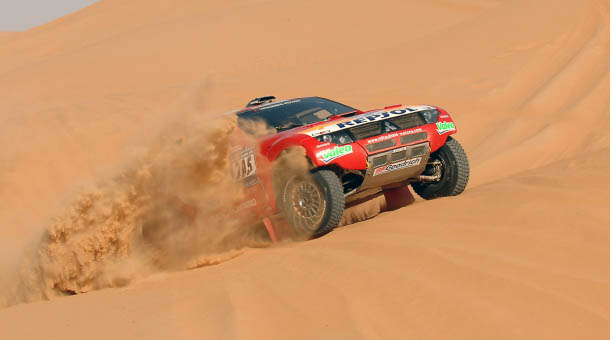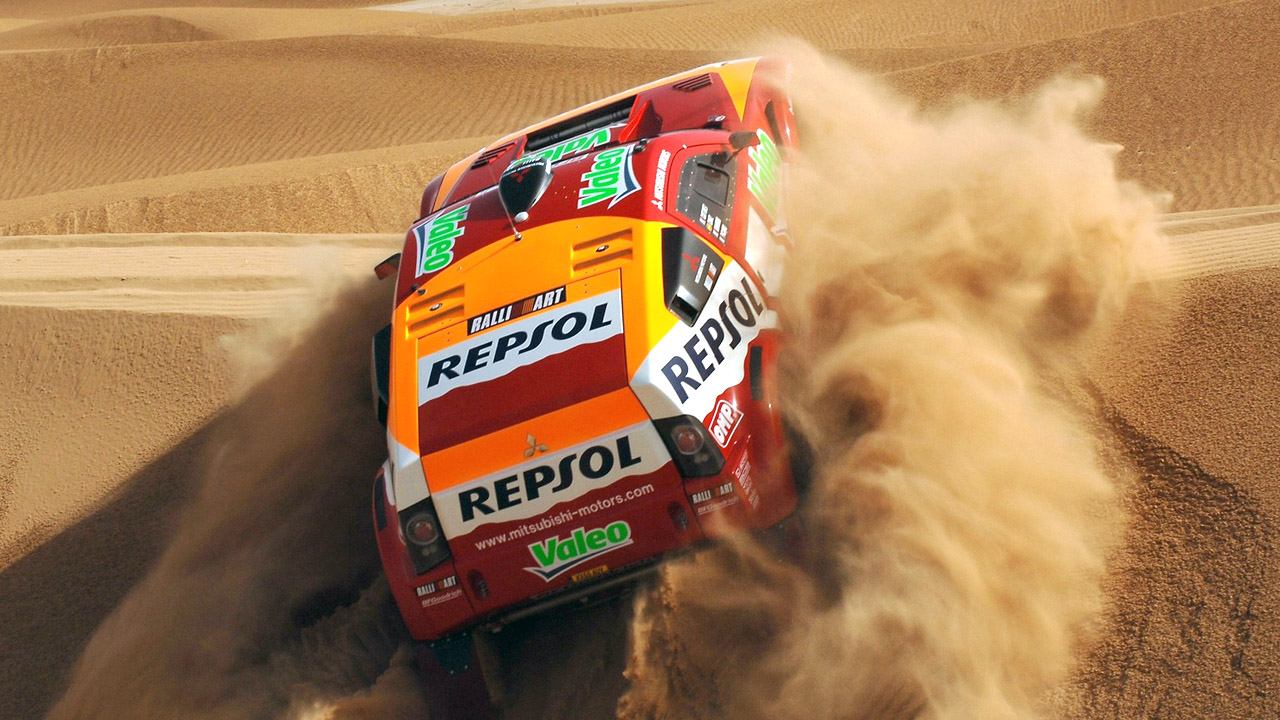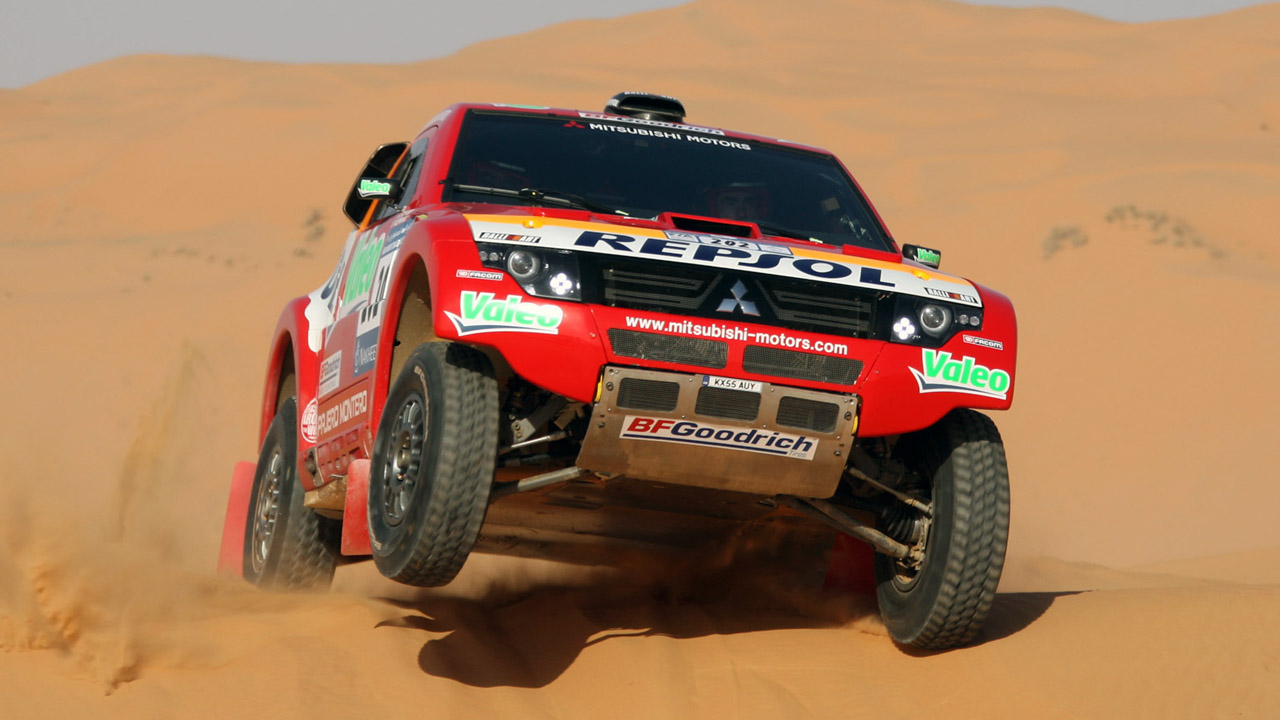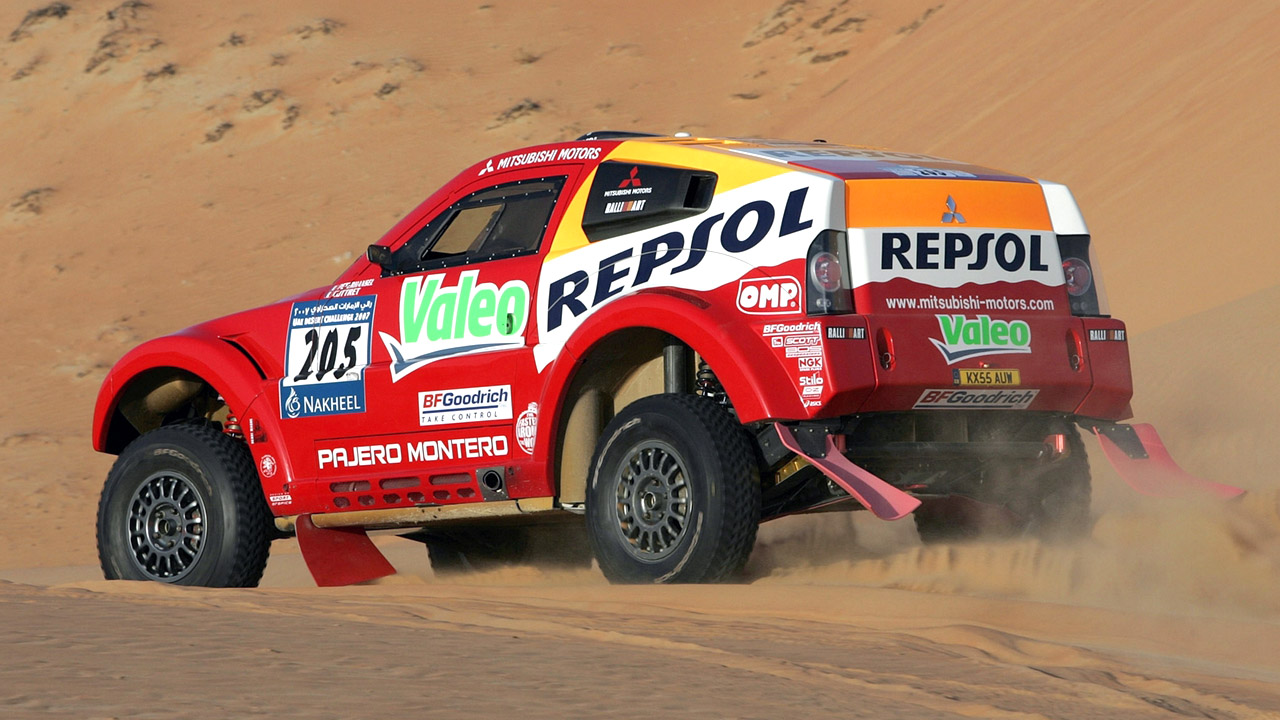Mitsubishi pajero evolution rally
Cars in the Super Production class are limited to a maximum width of 2000 mm and a maximum wheel travel of 250 mm. The Pajero Evolution complies fully with these regulations.
MMSP introduced several modifications to the Mitsubishi Pajero Evolution after a detailed test and development session in Morocco in July 2003. The major development was the successful transition from a 3.5-liter V6 engine to a 4.0-liter V6 unit.
The powerplant was built and developed in Japan. It was used for the first time during the two-week test in Morocco and powered the factory cars during the recent UAE Desert Challenge. The 4.0-liter unit was also fitted in Carlos Sousa’s Mitsubishi Portugal L200 Strakar.
«The new engine is now available in road applications in Japanese and US markets as a 3.8-liter alternative and we decided to develop it for a 4.0-liter application,» said Thierry Viardot, Technical Director at Mitsubishi Motors Motor Sports GmbH (MMSP).
MMSP has retained a six-speed sequential gearbox, although a new kinetic and hydraulic anti-roll bar system was tested extensively in Morocco and used for the first time during the UAE Desert Challenge.
Viardot has worked on developing this system with MMSP’s Operations Engineer Bernard Lindauer, MMSP’s Chief Engineer Max Felter and Engineer Mathieu Parent. Each of the four factory cars was set up in pre-Dakar specification in the UAE Desert Challenge in October.
«This new anti-roll bar system is similar to the one used so successfully by Citroen in the FIA World Rally Championship,» said Viardot. «It improves stability during cornering and ensures that the Evolution handles more like a WRC car. It is particularly useful on twisty special stages, narrow tracks and the traditional Prologue stage. Another of the system’s strengths is its adaptability on bumpy tracks and in sand holes.»
Lindauer joined the team in Macon after the Rally of Tunisia and has worked extensively on setting up this kinetic system. Using his WRC experience he has worked with spring and damper suppliers and improved the team’s quality control system.
The Morocco test was used to improve engine, transmission and differential cooling systems. «The changes we made were finally confirmed in the UAE,» said Viardot. «We changed the size and shape of the water radiator, improved the quality of the piping and the air ducts. It is now possible to remove the Mitsubishi diamond logo on the front grille of the car in extremely hot conditions. There is a mesh grille behind the diamond and this allows for better air flow and better cooling.»
Modifications have also been made to the suspension set-up and these were put into practice in the UAE. «We have worked on minor improvements, such things as spring ratios and damper cooling. The batches of components, such as driveshafts, we will use on the Dakar were also used in Dubai and this has allowed us to look closely at potential component failures, heat treatments and improve the reliability. The plan is to develop a totally reliable car. Apart from a noisy differential on Miki Biasion’s car, there was not one mechanical problem on the UAE Desert Challenge.»
MMSP now uses Brembo brakes on all cars and this contract extends to the WRC program. The discs are slightly larger and offer better rigidity and are less susceptible to overheating in extreme temperatures and BF Goodrich tires will be fitted to all entries.
A 500-liter fuel tank has been retained, but the minimum weight has been extended from 1750 kgs to 1825 kgs as per FIA technical regulations.
The interior roll cage has been reinforced around the windscreen and roof areas. A new foam-supported seat mounting bracket was tried for the first time in Stephane Peterhansel’s winning car during the UAE Desert Challenge. «This is a prototype design with a seat bracket rubber mounting that I took to the FIA and we have been allowed to use it,» said Viardot. «It is not homologated, but has been accepted. It reduces the risk of serious neck injuries.
«Other minor improvements have been made to the wheel nuts and wheel studs, which had a tendency either to work loose or become difficult to remove,» stated Viardot.
MITSUBISHI PAJERO EVOLUTION FOR 2004 DAKAR RALLY
(Super Production Cross-Country Cars)
Technical Specification
| OVERALL LENGTH | 4445mm |
| OVERALL WIDTH | 1978mm |
| WHEEL BASE | 2725mm |
| FRONT TRACK | 1750mm |
| REAR TRACK | 1736mm |
| ENGINE MODEL | Based on Mivec, 6-cylinder, 24-Valve, DOHC, adjustable inlet port, wet-sump oil system. |
| FUEL SYSTEM | ECI multi-point fuel injection |
| DISPLACEMENT | 3997cc |
| MAXIMUM OUTPUT | 270 PS / 5500rpm |
| TRANSMISSION | 6-speed Ricardo-type, sequential shift gearbox and mechanical gear selection |
| 4WD system | full time, mechanical centre diff lock |
| Front diff | Xtrac self-locking differential |
| Rear diff | Xtrac self-locking differential |
| SUSPENSION | |
| Front | Independent, double wishbones, coil spring |
| Rear | Independent, double wishbones, coil spring |
| Dampers | 2 Donerre shocks per wheel, fully-adjustable damping and new hydraulic anti-roll bar system |
| STEERING | Power-assisted rack and pinion |
| WHEEL STROKE | 250 mm front and rear |
| BRAKES | Front and rear: Ventilated Brembo discs with 6-piston Brembo calipers |
| WHEELS | Tecnomagnesio 7×16″ |
| TYRES | BF Goodrich 235/85 — 16 |
| MINIMUM WEIGHT | 1825 kgs |
| OTHERS | Aeronautic steel multi-tubular frame Honeycomb body floor and carbon fibre body |
| FUEL TANK CAPACITY | 500 litres |
MITSUBISHI PAJERO FOR 2004 DAKAR RALLY
(Super Production Cross-Country Cars)
Technical Specification
| OVERALL LENGTH | 4110mm |
| OVERALL WIDTH | 1955mm |
| WHEEL BASE | 2545mm |
| FRONT TRACK | 1700mm |
| REAR TRACK | 1700mm |
| ENGINE MODEL | Based on Mivec, 6-cylinder, 24-Valve, DOHC, |
| FUEL SYSTEM | ECI multi-point fuel injection |
| DISPLACEMENT | 3497cc |
| MAXIMUM OUTPUT | 270 PS / 6000rpm |
| TRANSMISSION | 6-speed |
| 4WD system | full time, mechanical centre diff lock |
| Front diff | self-locking differential |
| Rear diff | self-locking differential |
| SUSPENSION | |
| Front | Independent, double wishbones, coil spring |
| Rear | Independent, double wishbones, coil spring |
| Dampers | 2 Donerre shocks per wheel, fully-adjustable damping |
| STEERING | Power-assisted rack and pinion |
| WHEEL STROKE | 250 mm front and rear |
| BRAKES | Front and rear: Ventilated Brembo discs with 6-piston Brembo calipers |
| WHEELS | Tecnomagnesio 7×16″ |
| TYRES | BF Goodrich 235/85 — 16 |
| MINIMUM WEIGHT | 1750kgs |
| OTHERS | Aeronautic steel multi-tubular frame Honeycomb body floor and carbon fibre body |
| FUEL TANK CAPACITY | 500 litres |
Mitsubishi Motors Announces 2004 Dakar Line-Up
Mitsubishi Motors Corporation (MMC), one of the most successful manufacturers in the history of the Dakar Rally, has secured a formidable line-up for its assault on the 2004 event. Four official Mitsubishi Pajeros will take the start of this legendary event as Mitsubishi bids for its fourth consecutive Dakar Rally victory.
Double Dakar Rally winner Hiroshi Masuoka will spearhead the assault and the Japanese star will be joined by Frenchman Stephane Peterhansel, who has won the event six times on motorcycles, and double World Rally Champion Miki Biasion, all driving Pajero Evolutions. Rising German Andrea Meyer will form part of the official team, in a Pajero.
I hope we can repeat the 2003 year s result, when we were first, second and third, but it will be much more difficult in the upcoming rally, predicted Sven Quandt, Head of Mitsubishi Motors Motor Sports GmbH (MMSP). The Dubai results have instilled us with confidence that the Pajero is reliable over a longer distance endurance event in preparation for the Dakar.
Mitsubishi s command of the Dakar Rally is impressive and, since its first entry into the Paris-Dakar Rally back in 1983, the Japanese manufacturer has won no fewer than eight times. Its strength not only lies in the expertise of drivers, moreover, Cross-Country rallying requires unprecedented navigational skills which could well be Andrea Meyer s trump card. Alongside the young German woman is fellow countryman Andreas Schultz who has also claimed two victories in this legendary event. Schultz took his maiden win with former Mitsubishi driver Jutta Kleinschmidt back in 2001, and also guided Masuoka to his second win in 2003. His role with Meyer will be pivotal to her success. His navigational experience and ability to judge the conditions are of considerable advantage to the German lady-driver. The Mitsubishi Motors team will also have the invaluable assistance of Jean-Pierre Fontenay, one of its former Dakar drivers. While the Frenchman has retired from competition, he will act as the team s official test driver, drawing on his vast knowledge to assist in the set-up of the cars for this grueling event.
We have a professional team and very experienced drivers, added Quandt Hiroshi and Stephane have a lot of experience and the whole team is working well together. Now that Miki has driven the Pajero Evolution in Dubai, the Dakar Rally will be his second competitive outing. We know that he is a very constant, very reliable driver. Andrea Meyer will drive the fourth car, chiefly as a back-up for the other three. After her positive result in Dubai we expect that Andrea will enjoy a challenging drive during the Dakar with the factory team.
The 2004 Dakar Rally starts in France on January 1 and takes the crews south to North Africa before finishing on January 18 in the Senegalese capital of Dakar.
2004 Dakar Rally / FIA World Cup Cross-Country Rally Calendar
| Dakar *2 | January 1-18 |
| Baja Italian | March 11-14 |
| Rally Tunisie | April 3-12 |
| Baja Portugal | May 6-9 |
| Rally Morocco | June 1-6 |
| Baja Espana | July 15-18 |
| Orient Rally | August 7-15 |
| Por Las Pampas | September 15-21 |
| UAE Desert Challenge | October 11-15 |
*1 Montero in Spanish-speaking countries and USA
*2 2004 Dakar is not covered by the FIA World Cup Cross Country
Pajero Evolution Dakar Rally Raid — 2003
Впервые Mitsubishi участвовала в ралли Париж-Дакар в 1983 г. Выступая в классе не модифицированных серийных моделей, Эндрю Коуэн в первой гонке привел компанию к победе, а в 1985 г., в гонке прототипов, благодаря согласованным действиями Занироли и Коуэна заводская команда заняла первое и второе места. Новое нашествие на Дакар состоялось на Mitsubishi Pajero Evolution Dakar.
Болид был разработан французской компанией Sonauto, а не компанией-производителем. В 1988 г. Mitsubishi начала разработку собственного прототипа с трубчатой рамой и независимой подвеской на сдвоенных параллельных А-образных рычагах. Оснащенный 4-цилиндровым двигателем объёмом 2,6 л, автомобиль-монстр, которым управлял Кендзиро Шинозука, выиграл ралли Австралии в 1990-м и занял второе место в гонке Дакар 1991 года. В 1992-м благодаря улучшенным аэродинамическим характеристикам он занял все призовые места в Париж-Кейптаун, доказав свое превосходство.
В 1997 г. после запрета на использование прототипов в ралли Париж-Дакар, внедорожник переместился группу А (Т2-класса) созданной для некодифицированных серийных моделей, таких как Lancer WRC. Pajero представил модель Evolution. Машина позволила Кендзиро Шинозука стать первым японским гонщиком, победившим в состязании, а после того как были заняты 1-е четыре места, родилась империя Pajero.
В 2002 г. в класс Т2 вошли и новые модифицированные серийные автомобили. Авто для Чемпионата мира по авторалли был Паджеро с многотрубной рамой и карбоновым кузовом, оснащенный двигателем V6 объёмом 3,5 л. На этой машине Хироши Масуока выиграл мировые чемпионаты 2002 и 2003 гг.
Характеристики Mitsubishi Pajero Evolution Dakar
- Объём двигателя — 3497 см.куб.
- Мощность — 270 л.с.
- Крутящий момент — 352,8 Нм/3500 об/мин
- Привод / Наддув — Полный / АС
Если вы нашли опечатку, пожалуйста, нажмите на кнопку
или выделите фрагмент текста с опечаткой и нажмите Ctrl+Enter.



